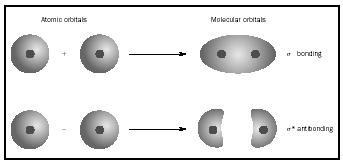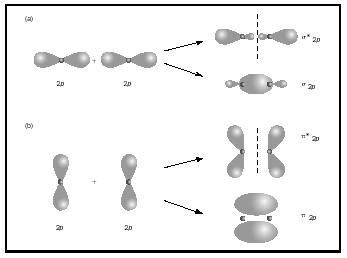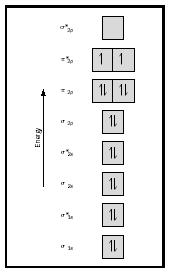The molecular orbital (MO) theory is a way of looking at the structure of a molecule by using molecular orbitals that belong to the molecule as a whole rather than to the individual atoms.

When simple bonding occurs between two atoms, the pair of electrons forming the bond occupies an MO that is a mathematical combination of the wave functions of the atomic orbitals of the two atoms involved. The MO method originated in the work of Friedrich Hund and Robert S. Mulliken.
When atoms combine to form a molecule, the number of orbitals in the molecule equals the number of orbitals in the combining atoms. When two very simple atoms, each with one atomic orbital, are combined, two molecular orbitals are formed. One is a bondingorbital, lower in energy than the atomic orbitals, and derived from their sum. It is called sigma. The other is an antibonding orbital, higher in energy than the atomic orbitals, and resulting from their difference. It is called sigma-starred ( σ *). (See the diagram in Figure 1.)

The basic idea might best be illustrated by considering diatomic molecules of hydrogen and helium. The energy diagrams are shown in Figure 2. Each hydrogen atom has one 1 s electron. In the H 2 molecule the two hydrogen electrons go into the lowest energy MO available, the sigma orbital. In the case of helium, each helium atom has two electrons, so the He 2 molecule would have four. Two would go into the lower energy bonding orbital, but the other two would have to go into the higher energy sigma-starred orbital.
Bond Order
The bond order for a molecule can be determined as follows: bond order = ½ (bonding electrons − antibonding electrons). Therefore, the H 2 molecule has a bond order of ½ (2 − 0) = 1. In other words, there is a single bond connecting the two H atoms in the H 2 molecule. In the case of He 2 , on the other hand, the bond order is ½ (2 − 2) = 0. This means that He 2 is not a stable molecule.
Multiple Bonds
Double or triple bonds involve two or three pairs of bonding electrons. Single bonds are always sigma bonds, but in multiple bonds the first bond is sigma, while any second or third bonds are pi bonds. The overlap of p orbitals can yield either pi or sigma MOs, as shown in Figure 3. When they overlap end to end, they form sigma orbitals, but when they overlap side to side, they form pi orbitals.

Consider now the oxygen molecule. The Lewis structure for oxygen is :Ö::Ö: The double bond is necessary in order to satisfy the octet rule for both oxygen atoms. The measured bond length for oxygen supports the presence of a double bond. Yet we know that this Lewis formula cannot be the correct structure for oxygen because oxygen is paramagnetic, which means that the oxygen molecule must have unpaired electrons.
Look now at the MO diagram for oxygen, which is shown in Figure 4. It still indicates a bond order of 2 [½(10 − 6) = 2], but it also shows two unpaired electrons.

Figure 4. MO energy diagram for O 2 . Eight electrons from each oxygen atom add up to 16 electrons in the O 2 molecule. They combine to form the molecular orbitals indicated above.
The MO theory also works well for larger molecules such as N 2 O, CO 2 , and BF 3 and for ions such as NO 3 − and CO 3 2− , in which the bonding MOs are delocalized, involving three or more atoms. It is especially useful for aromatic matic molecules such as benzene. In this case all six C atoms in the ring are equally involved in a delocalized pi electron cloud that envelops the entire molecule. The MO theory can even be extended to complex ions and to solids, including materials such as superconductors and semiconductors.
